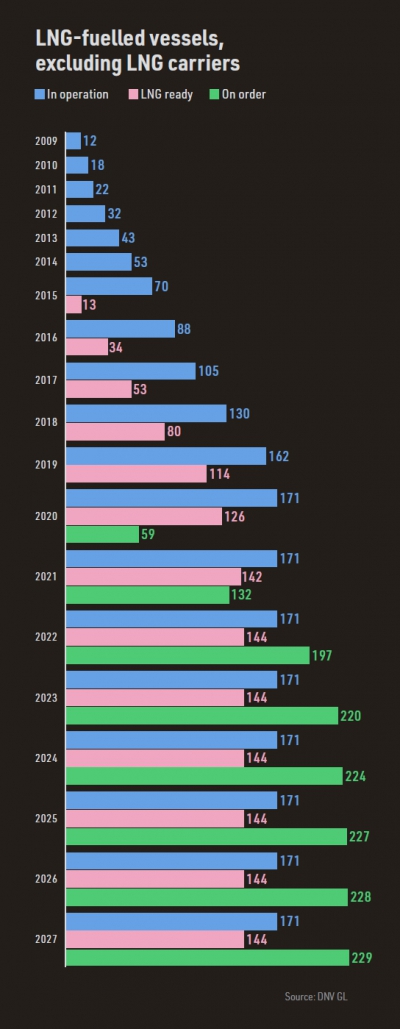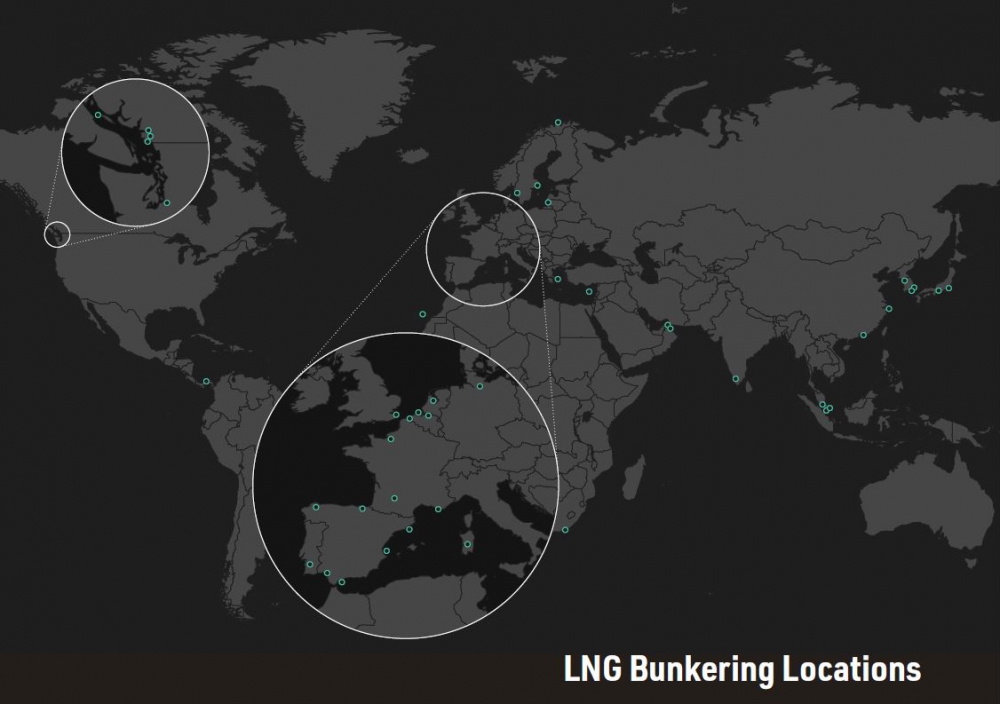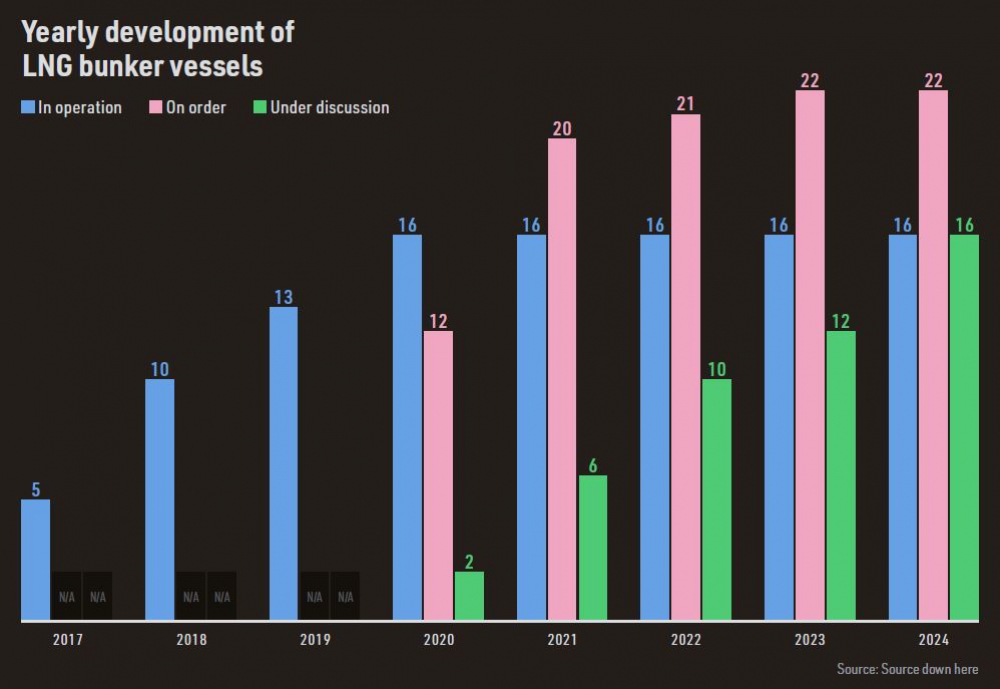LNG bunkering is becoming a global phenomenon [LNG Condensed]
LNG can be transferred to ships by bunkering vessels, from LNG bunker trucks or from onshore supply points. According to industry body SEA-LNG, LNG can now be delivered as a fuel at about 96 ports worldwide with a further 55 ports in the process of developing bunkering operations.
There is a clear trend towards the use of specialised bunkering vessels, which now number 16 up from 5 in 2017, according to classification society DNV GL. Industry body SEA-LNG in February said that there were another 27 under construction or on order. The fact that they have been ordered for ports around the world – in Europe, North America, Asia and Africa – allowing refuelling along major shipping routes, suggests the technology is taking off.
Rotterdam could have eight bunker vessels in operation by the end of this year, while Singapore will be operating its first vessel by the same time. LNG producers Total, Shell and Woodside Energy have all either ordered bunkering vessels or have launched tenders for them.
They are also to be used in a variety of settings, including in areas affected by ice. Gazprom is to charter a vessel with ice-breaking technology for use in the Baltic Sea by December.
Supply operations are now planned for some entire regions rather than just individual ports. For instance, in September, Sumitomo Corporation and Cryopeak LNG Solutions signed a memorandum of understanding to jointly develop an LNG bunker supply chain on the west coast of Canada, including in Vancouver.
The records for the biggest LNG bunkering vessel and largest LNG bunkering delivery are repeatedly being broken. DNV GL forecasts that LNG could account for 41% of all shipping fuel by 2050.
LNG is becoming a popular maritime fuel because of the perception that it is more environmentally friendly than heavy fuel oil, marine gas oil or marine diesel fuel. It certainly has a much lower sulphur content, as LNG contains almost no sulphur, providing a real option at a time when stringent sulphur emissions standards are being imposed around the world. It also produces fewer particulates and nitrogen oxides than oil.
However, some analyses have found that on a well-to-wake basis whether LNG generates fewer greenhouse gas emissions than the best oil-fired engines, depends on engine type, usage and the LNG fuel supply chain.
Bunkering options
Whether bunker vessels, bunker trucks or static refuelling points are used to deliver LNG fuel depends on the options available at any particular port and on which other activities are taking place on the quay at the same time. LNG vessels can be self-propelled ships with a substantial travel range and large capacities, but they can also be bunker barges that are towed by tugs to LNG-fuelled ships for bunkering. The tanks on such barges can be fitted in the hull or on the deck.
Mooring LNG bunker vessels on the offshore side of the receiving ship or at anchorage separates the bunkering operation from the quay, isolating it from any other quayside activities and protecting the quay in the event of an accident.Safety is also ensured by making sure that the two vessels are safely moored, with spacing between them to prevent damaging collisions. By volume, about 1.8 times as much LNG needs to be bunkered than heavy fuel oil because of its lower density.
The loading limit is always lower than the filling limit to allow for changes in LNG density at different temperatures. In addition, a small amount of LNG, called the heel, must be left in the tank even prior to bunkering, to keep the tank cool. This is generally about 5% of the tank’s capacity, although the amount varies according to the tank size and shape and on how much heat is transferred from adjacent areas.
Cryogenic challenges
Tanks have to be filled with LNG without emitting any vapour because the latter can be explosive. The main hazards are accidental spills, the risk of cryogenic material leaking, explosions and fires. The cryogenic nature of LNG means that operators need special equipment to deal with it to avoid injury to personnel and damage to steel structures. Cryogenic pipes are usually thermally insulated from the ship structure to prevent the extreme cold being transferred and causing damage.
In addition, the extremely low temperature of the LNG means that anywhere on the hull or deck that LNG could spill is either cold resistant or sufficiently protected. Apart from the quick connect/disconnect (QC/DC) couplings, stainless steel drip trays are used to provide spillage protection anywhere that leakage is possible, as well as in the LNG piping system. In addition, the area below any flanged connection is often fitted with spray shields.
A variety of organisations, including the Society of International Gas Tanker and Terminal Operators and the International Maritime Organization, have drawn up regulations to ensure the safety of LNG bunkering, including the use of emergency shut-down systems (ESD). The ESD, which can be controlled from both the LNG receiving ship and the bunker vessel, allows the manifold valves, stopping pumps and closing tank filling valves to be quickly closed in the event of an emergency, such as a fire, detection of gas, power failure or excessive ship movement.
The bunker hose is connected to the ship by a QC/DC pressure tight coupling with valves to ensure that it cannot be disconnected while LNG is flowing.The size and flow rate of the bunker pipe depends on the LNG fuel tank capacity and pressure, plus the vapour return capacity and flow rate limits. The time taken to refuel is also affected by how often operators want to refuel and whether they want to completely fill their tanks.
The process can be speeded up by cooling the fuel tank before bunkering and returning the vapour to the bunker vessel, although the use of a vapour return line is not compulsory.
Tank options
Only certain types of LNG storage tank are permitted under the International Code for the Construction and Equipment of Ships Carrying Liquefied Gases in Bulk (IGC Code). One option is non-independent membrane tanks, which consist of a thin membrane supported through insulation by the adjacent hull structure and so are not self-supported. These require the use of a secondary barrier that can contain the LNG, but such tanks are limited to a maximum vapour pressure of 0.7 bar.
There are three types of independent tanks: A, B and C. Type A is also limited to 0.7 bar and are shaped liked prisms built on plane surfaces. Type B tanks, which can be prisms or spherical, have been tested using analytical tools to determine stress levels, fatigue life and crack propagation characteristics, and require a partial secondary barrier.
Type C independent tanks are designed for pressures greater than 2 bar and are cylindrical or spherical in shape. They do not require the provision of a secondary barrier. Tanks can be filled from the top, from the bottom, or both. Top filling allows the LNG to cool the vapour in the tank, thereby reducing pressure and temperature in the tank, but using both filling points helps to mix the new LNG fuel with the remaining heel.





